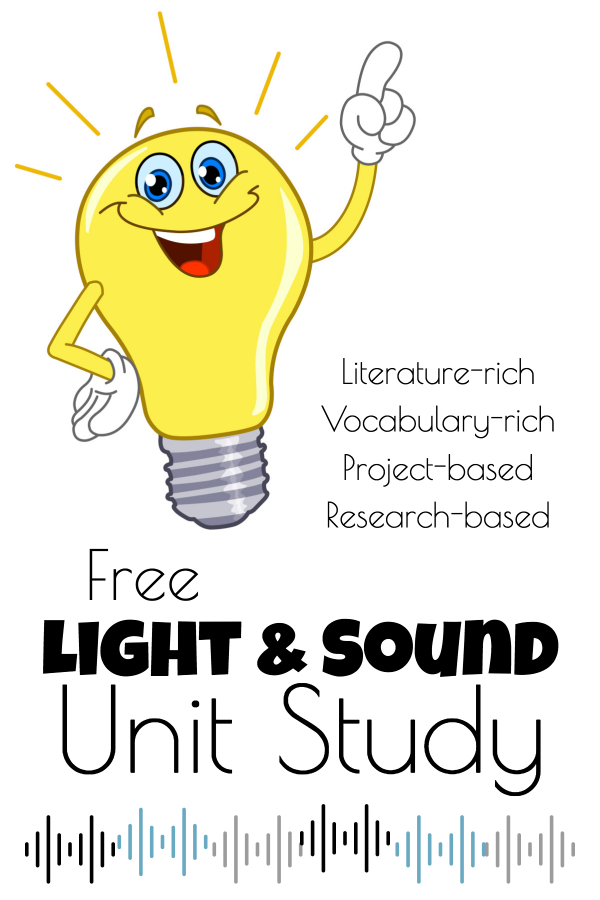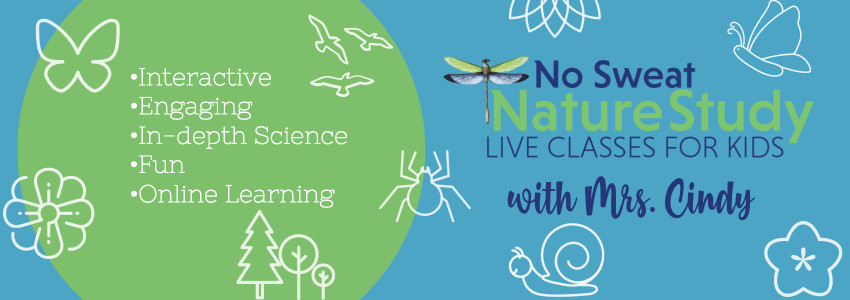Light and Sound Unit Study
A light and sound unit study works well in a homeschool physics science rotation. Packed full of meaningful activities, experimentation, and exploration, this unit study is perfect for 3rd-7th-grade students!
Great informational books and biographies set the stage, while project-based and research-based activities allow for deeper learning on certain topics of interest.

Get a downloadable copy of this unit study below!
This post contains affiliate links.
Light and Sound Books
A literature-based unit study provides easy connections to a wide variety of topics. These particular informational and biographical books are great for gaining a broad understanding of light, color, sound, and other physics topics. Meet integral historical figures in the world of light and sound, too.
There is no need to read every book on this list. Just be sure to read enough to cover the topics of light and color thoroughly.
The Science of Sound and Music by Shar Levine and Leslie Johnstone
Light and Its Effects by Jenna Winterberg
Sound Waves and Communication by Jenna Winterberg
Super Sonic: The Science of Sound by Jay Hawkins
Experiments in Light and Sound with Toys and Everyday Stuff by Natalie Rompella
The Magic School Bus Gets a Bright Idea by Nancy White (video here)
The Magic School Bus in the Haunted Museum by Linda Beech (video here)
Illuminating the World of Light with Max Axiom, Super Scientist by Emily Sohn
Adventures in Sound with Max Axiom, Super Scientist by Emily Sohn
The Basics of Sound by Christopher Cooper
Bright Ideas: The Science of Light by Jay Hawkins
Light and Color by Peter Riley
Light by David Burnie
Helen Keller in Her Own Words by Caroline Kennon
Who Was Thomas Alva Edison? by Margaret Frith
Thomas Edison: Young Inventor by Sue Guthridge
Who Was Alexander Graham Bell? by Bonnie Bader
National Geographic Readers: Alexander Graham Bell by Barbara Kramer
Light and Sound Unit Study Vocabulary
Vocabulary lessons can be casual:
- Call out a vocabulary word and ask your child to attempt to spell it. To make a nice attempt, my son is encouraged to think about all the spelling rules previously learned through the Logic of English Essentials curriculum.
- Ask your child to guess the meaning of the word. If unknown, use it in a sentence. If you’ve studied Latin or Greek roots, give a reminder or two. If still unknown, provide a dictionary (or on the internet). Ask your child to then use it in a sentence.

Light and Sound Unit Study Projects
The unit studies in our homeschool almost always include project-based or research-based learning activities. These are excellent opportunities to turn some learning over to children. Allowing them to show what they learn in meaningful ways encourages research, writing, creating, and public speaking.
From the list below, allow your child to choose only a handful to complete. Choices are important, even if a little guidance is necessary. Kids take more ownership of the final product when they have a say in projects. Expect the choices to cover a varied range of activities. In other words, intermingle easier activities with some that require more research, writing, and planning.
How many to choose depends on a child’s age and how long you plan to spend on this study. For example, if spending 3-4 weeks on this topic, the front end of the study will likely be loaded with books, videos, and experiments. The last week or two can be turned over to the completion of projects.
You can learn more about how to do project-based learning here.

Research-Based Light and Sound Activities
Write the definitions of each vocabulary word on a note card. Create a simple game to play that will help you and a friend remember the definitions. (Language Arts, Science)
Research Helen Keller and create a video narration of her life. (Language Arts, History, Science, Technology)
Research to learn how sound travels. Create a detailed image on poster board to describe the process. (Language Arts, Science, Art)
Write a list of as many stringed instruments as you can think of. Afterward, look up a complete list. Did you miss any? If there are any on the complete list that you haven’t heard of before, listen to each of them on YouTube. (Music, Language Art, Technology)
Choose your favorite stringed instrument and write a report. Be sure to include at least one paragraph about how the instrument works and another paragraph about its origin, plus any other interesting things you learn during your research. Include a labeled diagram, too. (Music, Language Arts, Science, History, Social Studies, Art)
Instruments like organs, trumpets, flutes, and horns make a sound because air is vibrating inside them. Choose one of the instruments mentioned (or another that is similar) and find out how it works. Make an illustrated chart explaining in detail how the instrument works. (Music, Science, Art, Language Arts)
Read a biography of Thomas Alva Edison. Dress up as him and tell a short narrative about his life. (History, Science, Language Arts)
Thomas Edison made the first sound recordings using his phonograph invention. Watch a YouTube video to see how phonographs work and be ready to explain the process to your family. (Science, Technology, Language Arts)
Research Alexander Graham Bell and make a timeline of his accomplishments. (History, Language Arts, Science)
What is echolocation? Write a paragraph explaining it and create a chart of animals that use echolocation to navigate. (Science, Language Arts)
Research and write a thorough list of the properties of light. (Science, Language Arts)
Refraction is the bending of light. An interesting effect caused by refraction is a mirage. Study this occurrence and tell a fictional story that includes a mirage as part of the setting. (Language Arts, Science)
What causes rainbows? See if you can write a song or poem to explain what you learn. (Language Arts, Science)
Besides the phonograph, Thomas Edison also invented the electric light bulb. How did he discover it, and how did it work? Share the information you learn in a simple skit. (Language Arts, Science, History)
Hands-On Light and Sound Activities
Make a flame dance by completing this experiment. Then research sound vibrations to learn how the experiment works. Present the experiment to family members after dinner explaining the science behind the results. (Science, Language Arts)
- Cut the bottom off a plastic soda bottle with scissors.
- Cut a square from a plastic bag that’s at least 1/2 inch bigger than the base of the bottle. Attach it to the base with a rubber band.
- Light a tea light candle, and point the neck of the bottle towards the flame.
- Tap the plastic square without moving the bottle. The candle flame will flicker due to the sound waves! (Science)
Visit a musical instrument store or another place where you can be exposed to a variety of stringed instruments. Carefully, pluck the strings of a few different instruments – if it is allowed – to test the sounds. Ask questions of the store clerks to see if they can help you understand why each instrument and each string sounds different. (Field Trip, Science, Music)
Do sound waves move things? Find out by completing the following experiment: (Science)
- Make a drum by placing a piece of wax paper over a paper cup. Secure the wax paper with a rubber band.
- Place two small objects (such as Legos or noodles) on the drum. Trace around them with a marker.
- Place a metal pan upside down next to the drum. Bang on the pan with a toy hammer.
- Watch what happens to the Legos or noodles. Did they move outside of your traced lines?
Fill a clear glass with water and dip a pencil inside. What do you see? This is a simple demonstration of refraction. Research refraction and be ready to tell about it as you complete this demonstration for your family. (Language Arts, Science)
Make an indoor rainbow with this simple activity. Be ready to explain the results. (Science)
- Find a sunny window. Close the blind or curtain, leaving only a small gap to let some direct sunlight in.
- Hold a CD, shiny side up, in the beam of sunlight.
- Reflect the light onto a piece of white paper.
- Change the angle of the CD. You will see a variety of different rainbow patterns.
Printable Light and Sound Unit Study
For your convenience, I’ve created a quick reference to all the books, vocabulary, and activity ideas from this post! Grab the 6-page printable light and sound unit study by entering your email address below.
Products You May Like:
-
 Unit Study Masterclass$20.00
Unit Study Masterclass$20.00 -
 Product on saleHow To Plan Student-Led Classes in High SchoolOriginal price was: $20.00.$10.00Current price is: $10.00.
Product on saleHow To Plan Student-Led Classes in High SchoolOriginal price was: $20.00.$10.00Current price is: $10.00. -
 50 States Notebooking Pages$12.00
50 States Notebooking Pages$12.00
Other Posts You Might Like:





















